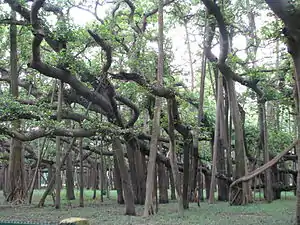The Great Banyan
The Great Banyan is a banyan tree (Ficus benghalensis) located in Acharya Jagadish Chandra Bose Indian Botanic Garden, Shibpur, Howrah, near Kolkata, India.[1] The great banyan tree draws more visitors to the garden than its collection of exotic plants from five continents. Its main trunk became diseased after it was struck by two cyclones, so in 1925 the main trunk of the tree was amputated to keep the remainder healthy; this has left it as a clonal colony, rather than a single tree. A 330-metre-long (1,080 ft) road was built around its circumference, but the tree continues to spread beyond it.

| The Great Banyan | |
|---|---|
 The Great Banyan, c. 2011 | |
| Species | Banyan (Ficus benghalensis) |
| Location | Acharya Jagadish Chandra Bose Indian Botanic Garden, Shibpur, Howrah |
| Height | 24 m (79 ft) |
| Date seeded | before 1800 |
Botanical classification
Botanically known as Ficus benghalensis, and belonging to the family Moraceae, the tree is a native of India. The fruit is like a small fig and is eaten by some people. It tastes sweeter than fig. The banyan plant is seen sometimes growing from the little wet dust deposits on buildings because birds carry them around for eating. The fruit is red and when ripe gets softer.
History and description

The Great Banyan tree is believed to be at least 250 years old, and has been referenced in many travel books, going back to at least the nineteenth century. Early travel writers found it to be noteworthy due to its large size and its unusually high number of prop-trunks. It has survived two great cyclones in 1864 and 1867, when some of its main branches were broken. With its large number of aerial roots, which grow from the branches and run vertically to the ground, The Great Banyan is said to appear more like a dense forest than as an individual tree.
The tree survives without its main trunk, which decayed and had to be removed in 1925. A monument has been erected to the dead trunk near the tree's center, but the marker is hardly accessible to visitors, who seldom venture within the tree's thick inner tangle of roots and branches. Visitors generally prefer to access only the perimeter of the tree. The area occupied by the tree is about 18,918 square metres (about 1.89 hectares or 4.67 acres). The present crown of the tree has a circumference of 486 m. and the highest branch rises to 24.5 m; it has at present 3772 aerial roots reaching down to the ground as a prop root. Its height is almost equivalent to the Gateway of India.
The tree lost several prop roots when Cyclone Amphan passed through West Bengal on 20 May, 2020.[2][3]
See also
| Wikimedia Commons has media related to The Great Banyan. |
- Thimmamma Marrimanu (The World's Largest Banyan Tree)
- List of Banyan trees in India
- Midh Ranjha Tree
- Dodda Alada Mara
- List of famous trees
Citations
- Sambamurty 2005, p. 206.
- "Winds fell old giants at Botanic Garden, Horti Society & Lake". The Times of India.
- "Storm strikes 270-year-old Great Banyan Tree". www.telegraphindia.com.
References
- Sambamurty, A.V.S.S. (2005), Taxonomy Of Angiosperms, I.K. International Publishing House Pvt. Limited, ISBN 9788188237166
External links
- The Great Banyan Tree. Atlas Obscura



